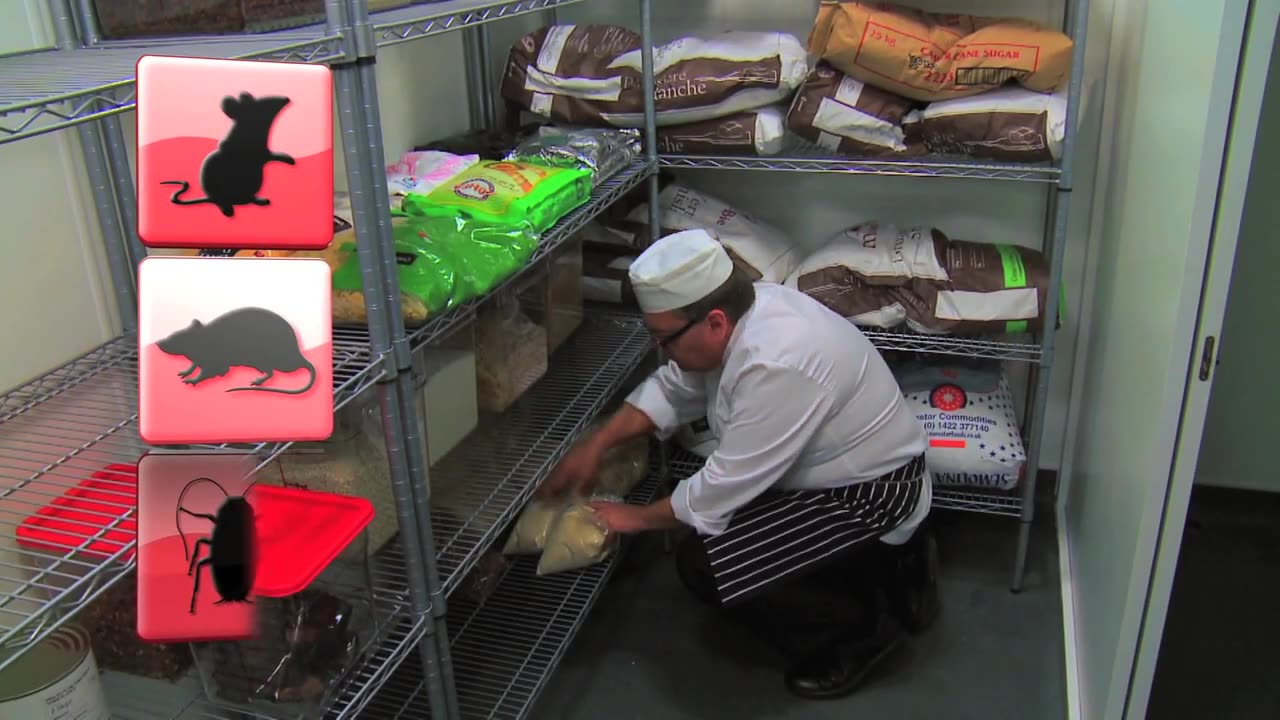Premium Only Content

Food safety coaching (Part 3)- Pest control
### **Food Safety Coaching (Part 3) – Pest Control**
Effective pest control is a critical component of food safety. Pests such as rodents, insects, and birds can carry harmful bacteria, viruses, and parasites that pose serious health risks. Ensuring that food preparation and storage areas are free from pests helps prevent contamination and preserves the quality of food.
---
### **Why Pest Control Matters**
1. **Prevents Contamination:**
- Pests, including flies, rodents, and cockroaches, can carry harmful microorganisms like **Salmonella**, **E. coli**, and **Listeria**, which can contaminate food and surfaces.
2. **Maintains Hygiene Standards:**
- Pest activity can create an unclean and unsanitary environment, which is not only dangerous but also may result in legal violations and loss of consumer trust.
3. **Protects Food Quality:**
- Pests may damage food by chewing through packaging or contaminating it, leading to product spoilage or waste.
---
### **Pest Control Strategies**
#### **1. Preventive Measures (Best Practices)**
- **Seal Entry Points:**
- Inspect the premises for any gaps, cracks, or holes where pests could enter. Seal doors, windows, and walls to block access points.
- Install **door sweeps** on exterior doors to prevent rodents and insects from entering.
- **Proper Waste Management:**
- Dispose of food waste regularly in **sealed bins** and store waste outside in **covered containers**.
- Ensure trash is removed from food preparation and storage areas frequently.
- **Maintain Cleanliness:**
- Clean food prep and storage areas regularly, including areas that might not be frequently accessed, like under equipment.
- Keep shelves, counters, and floors free of food debris that might attract pests.
- **Store Food Properly:**
- Store food in **airtight containers** and elevate it off the floor to prevent pests from accessing it.
- Regularly check food supplies for signs of pest infestation (e.g., holes, droppings, or damage to packaging).
#### **2. Monitoring and Inspection**
- **Regular Inspections:**
- Conduct daily checks for pests, especially in food preparation areas, storage rooms, and trash disposal zones.
- Look for signs of pests such as droppings, nests, or chewed packaging.
- **Pest Traps:**
- Use traps (glue traps, snap traps) and monitoring devices to detect the presence of pests. Regularly check and maintain traps to ensure they are working effectively.
- **Identify the Type of Pest:**
- Knowing which pests are active in your area (e.g., cockroaches, rodents, flies) helps tailor control methods. Each pest type requires a different approach.
#### **3. Pest Control Products**
- **Non-Chemical Control:**
- Use **insect light traps** to capture flying insects in kitchens and food service areas.
- Consider natural pest repellents (e.g., mint oil for rodents or diatomaceous earth for insects).
- **Chemical Control (When Necessary):**
- If using pesticides, apply them outside the food preparation areas and in compliance with local regulations. Always choose food-safe, non-toxic options and follow the manufacturer’s instructions.
- Consider hiring a professional pest control service to apply pesticides and provide expert advice.
#### **4. Professional Pest Control Services**
- **Engage Certified Pest Control Experts:**
- A licensed pest control company can provide specialized services, including regular monitoring, treatment, and advice on preventing pest issues.
- They can perform in-depth inspections and offer solutions that are compliant with food safety regulations.
- **Routine Service Agreements:**
- Many pest control companies offer ongoing service contracts that ensure your premises remain pest-free with regular inspections and treatments.
---
### **Common Mistakes to Avoid**
1. **Ignoring Early Signs of Infestation:**
- Address pest problems immediately upon detection to prevent widespread contamination and damage.
2. **Improper Waste Disposal:**
- Failing to store waste correctly or allowing waste to build up creates a breeding ground for pests.
3. **Overuse of Pesticides:**
- Over-relying on chemical treatments can be harmful to food safety and may lead to pesticide resistance. Use pesticides only when necessary and as per safety guidelines.
4. **Not Training Staff:**
- Employees should be trained on recognizing the signs of pests and following protocols for maintaining cleanliness and managing waste. Without proper training, pest issues can easily go unnoticed.
---
### **Key Tips for Effective Pest Control**
- **Seal all food containers and storage areas.**
- **Keep external areas of the building clean and well-maintained.**
- **Ensure that doors and windows are kept shut or properly sealed to avoid pest entry.**
- **Use pest control methods that comply with food safety and environmental regulations.**
- **Make pest control a part of your daily operations, including inspections and reporting.**
- **Involve employees in maintaining pest-free areas by encouraging vigilance and clean work habits.**
---
### **Key Reminder**
Preventing and controlling pests is a shared responsibility between management and staff. Regular maintenance, proper storage, waste management, and the use of pest control methods are vital to ensuring food safety and maintaining a clean, hygienic environment.
Would you like advice on how to handle a specific type of pest or need recommendations for professional pest control services?
-
 6:43
6:43
HSESafetyInformation
6 months agoLahori Chanay Recipe - Lahori Cholay Recipe - Chana Chana Masala
57 -
 3:23:21
3:23:21
MattMorseTV
4 hours ago $9.08 earned🔴Conflict in EASTERN EUROPE.🔴
49.5K22 -
 50:17
50:17
Sean Unpaved
2 hours agoVikings vs. Bears MNF Thriller: J.J. McCarthy's Clutch Comeback & NFL Week 1 Recap
11.9K2 -
 LIVE
LIVE
StevieTLIVE
1 hour agoStevie RETURNS for Warzone Duos w/ Spartakus
30 watching -

Mally_Mouse
3 days ago🎮 Let's Play!! Toontown (Rewritten) Tuesday!
5.48K1 -
 LIVE
LIVE
LIVE WITH CHRIS'WORLD
3 hours agoLIVE WITH CHRIS'WORLD - WHAT HAPPENED TO GRETA?!
92 watching -
 LIVE
LIVE
MissesMaam
3 hours agoVariety Stream💚✨
60 watching -
 1:05:46
1:05:46
BonginoReport
4 hours agoWe Don’t Hate The Media Enough - Nightly Scroll w/ Hayley Caronia (Ep.130) - 09/09/2025
80.6K44 -
 LIVE
LIVE
Fragniac
1 hour ago🔴 LIVE - FRAGNIAC - LET ME AT EM❗( -_•)╦ ╤─💥
39 watching -
 5:13:18
5:13:18
The Rabble Wrangler
17 hours agoThe Best in the West | New Weekly Mission Grind in BF2042
1.26K